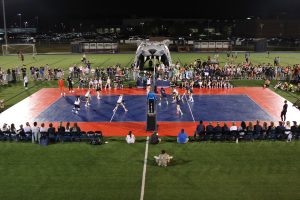Bussing shortages have forced athletes to adapt to an inconsistent traveling schedule
The district has been working with First Student to help combat the bus driver shortage
March 22, 2023
Bus driver shortages have affected almost every industry and school transportation is no exception. The lack of bus drivers has forced students to adapt to inconsistent bussing schedules that often cause them to arrive at an opposing team’s school hours before they play.
Head boys basketball coach Kurt Bangle and his athletes first became affected by the driver shortage after the return to sports following the COVID-19 pandemic.
“[The bus driver shortage has] still just continued. [It’s] something that’s not easily fixed at the moment.” Bangle said. “A lot of times, we’re getting students out during their last block of the day so students will arrive around 2 p.m. so they’ll have about two hours before their game starts to go sit in some classroom or hang out around whatever school we go to.”
Buses are provided to the district through an outside company called First Student. According to Bangle, this leaves the district with little control of the bus schedules.
Rob Moser, the coordinator of safety and transportation for the district, said in an email that the staffing issues “mirror what we’re seeing in other areas of employment.”
The higher licensing requirements needed to work as a bus driver results in a smaller group of qualified applicants for the position. Moser reports this issue is something the district recognizes and is working with First Student to help adapt to the current circumstances.
“The district has assisted First Student by advertising for new drivers on the district’s website and allowed for school buses with advertisement banners to be placed on district property,” Moser said. “First Student is trying to attract new drivers to the job by getting creative with advertising methods and reaching out to the community through new avenues, but the challenge persists.”
Moser also recognized how schools within the district have been supportive despite current transportation issues and appreciates the relationship the district has with First Student.
“That strong partnership has helped us continue transportation services nearly unchanged in this district,” Moser said. “While other districts around us have implemented strategies to reduce the amount of service they provide as a result of their staffing shortages.”
As a result of the inconsistent schedules, Junior varsity volleyball player, Kaitlyn Burke, has found ways to stay on top of her school work while missing the entirety of her last block on away game days. She spends her time working on her homework on the bus or inside the opposing team’s school.
“[If] we leave at 2 p.m., but our game is not until 4 p.m., we would have to do our homework on the bus,” Burke said. “When we got there, [the opposing school] would give us an individual study room. We’ve learned we need to tell our teachers [we’re leaving early] in advance. Throughout the season, we learned to help each other with our homework.”
Sophomore basketball player Addie Riffel, who frequently misses her fifth block for every away game, notices the schedule adding unneeded stress to her academic career. However, Riffel has managed to stay on top of her schoolwork and has kept herself from falling behind in the classes that she frequently misses.
“Last year I had math fifth block and that was a class that was hard to miss because it’s hard to teach yourself math at home so that was difficult,” Riffel said. “I’ve never struggled too much with making up work and I’ve always managed to catch up when I get behind.”
As homework isn’t always an option, Bangle finds the biggest problem for his players is finding productive activities to occupy the players time with before they begin warming up for their game.
“The biggest thing is them trying to fill that time whenever they get over to an opposing school. You don’t know if you have a classroom [so students don’t always] bring their computers to work on things but we’re not always guaranteed to have a classroom.” Bangle said. “[The hardest part] is trying to figure out how to keep those students doing something and not just kind of sitting around the whole time.”

Riffel and the girls basketball team spend their time not only doing school work but spending time together and growing closer as a team.
“You really just hang out with your teammates and spend time together until it’s time to play,” Riffel said. “Sometimes the girls will braid each other’s hair and do that sort of thing while we wait or we’ll just sit and talk or walk around.”
With the school having no direct control of the issue, head girls basketball coach Adam Runyan hopes school administrators can continue to help accommodate schools when arrival times are irregular.
“With every single school in the state struggling with this issue, I think it’s a matter of people being flexible. Hopefully, more bus drivers sign up to drive for the bus companies,” Runyan said.










